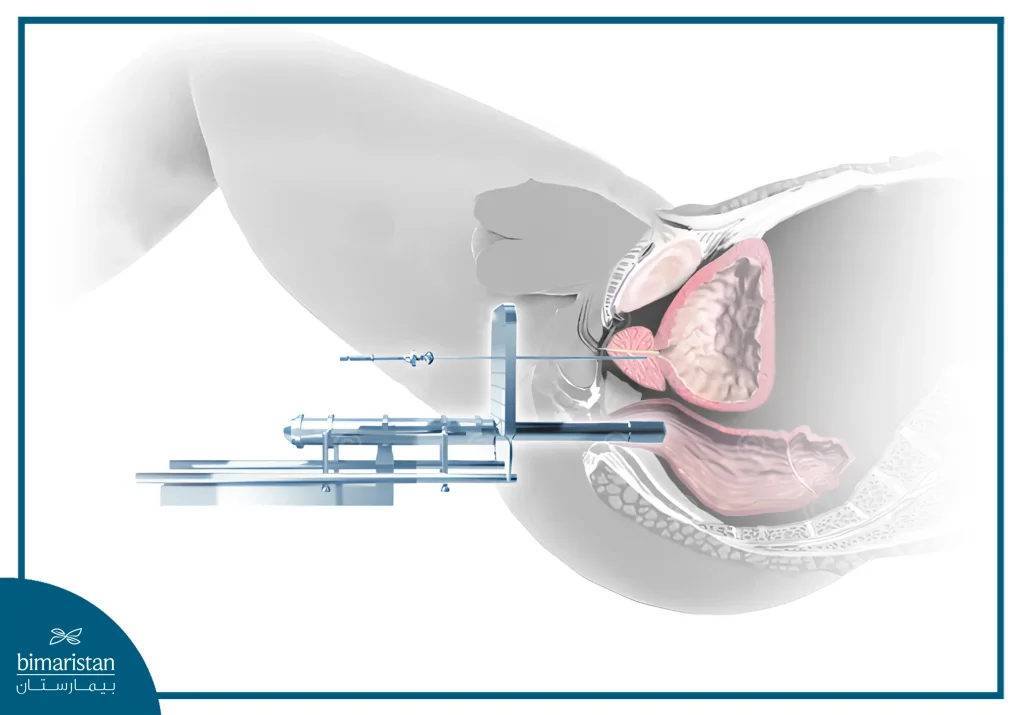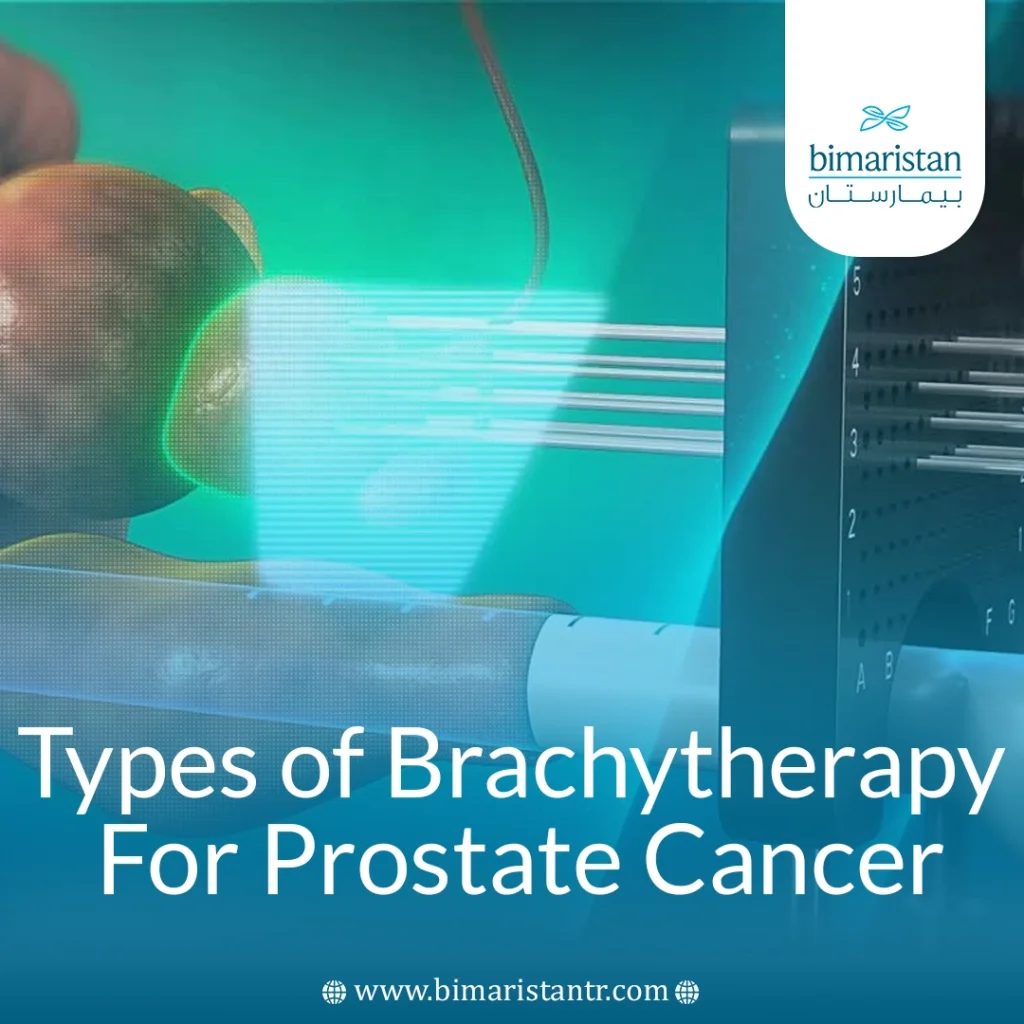Prostate cancer remains one of the most prevalent malignancies in men over 50, with treatment options including surgery, external beam radiation therapy, and brachytherapy, now considered a highly advanced technique.
Recent research indicates that brachytherapy offers cure and survival rates comparable to surgery for localized prostate cancer, while often providing better post-treatment quality of life. In this article, we explore the types of brachytherapy for prostate cancer and highlight the key differences between them.
What is prostate brachytherapy?
Brachytherapy is a type of internal radiation therapy in which a radioactive source is inserted into the prostate gland. These sources emit radiation that damages the DNA in cancer cells, causing them to gradually die over weeks to months. The radiation is delivered with high precision using 3D planning systems that integrate CT or transrectal ultrasound data and calculate the radiation dose distribution to cover the entire tumor while avoiding exceeding the permissible limits for neighboring organs.

Types of brachytherapy for prostate cancer
There are different types of brachytherapy for prostate cancer, divided into low-dose rate (LDR) brachytherapy and high-dose rate (HDR) brachytherapy.
Low-Dose Rate (LDR) brachytherapy
It is a technique of implanting permanent radioactive seeds into the prostate that emit a low dose of radiation for 2 to 6 months, until the radioactivity has completely decayed.
Radioactive isotopes used
Several radioactive isotopes are used, such as:
- Palladium-103: Preferred in cases that require a faster dose over a shorter period of time.
- Iodine-125: It emits low-energy gamma rays, making it ideal for long, continuous doses.
- Cesium-131: It is characterized by rapid delivery of the full dose over a short period, reducing chronic urinary symptoms.
How low-dose brachytherapy works
Low-dose brachytherapy involves several steps:
- Pre-treatment planning:
- Computer programs are used to map the seed distribution according to the shape of the gland and tumor
- Transrectal ultrasound is performed to determine the shape and size of the prostate with millimeter accuracy
- Implanting seeds:
- The patient is given either spinal or general anesthesia
- The doctor inserts ultrasound-guided fine needles through the perineum into the prostate
- Radioactive seeds are injected into the gland according to a numerical plan, at an average rate of 60–120 seeds
- Post-procedure:
- The patient is discharged the same day
- A CT scan is performed two weeks later to confirm the seed placement
- The radiation levels outside (the implant) are very low, but it is advisable to avoid direct contact with pregnant women and children during the initial two weeks

Advantages of low-dose brachytherapy
Low-dose brachytherapy is characterized by:
- A short procedure that doesn’t require a long stay
- Effective for treating low-risk localized tumors
- In most cases, no additional external beam radiation therapy is required
- Reduces the likelihood of affecting erections compared to surgery
Disadvantages and complications of low-dose brachytherapy
Low-dose brachytherapy may be associated with some complications, such as:
- Minor risk of subsequent urethral stricture
- Temporary urinary symptoms such as burning, frequent urination, and urinary retention
- Progressive erectile dysfunction occurs in 15-25% of cases years after the procedure
- In some rare cases, it may be associated with radiation proctitis or mild bleeding
High-Dose Rate (HDR) densitization
It involves temporarily inserting a high-intensity radioactive source into the prostate through microtubes, which is then withdrawn after delivering the prescribed dose. The isotope used is Iridium-192, a powerful electronically controlled radiation source that allows the radiation position and exposure time to be precisely adjusted. The number of sessions is 2-4 within 24-48 hours, depending on the center’s protocol and tumor type.
How high-dose brachytherapy works
- Pre-treatment planning: Images of the prostate are precisely analyzed to determine where a higher dose is needed (usually in the center of the tumor)
- Therapeutic procedure: Under general or spinal anesthesia, plastic catheters are inserted through the perineum into the gland. The catheters are connected to a control device that moves the radioactive source inside for short periods of time (10-20 minutes), and after the session is completed, the catheters are completely removed
Uses of high-dose brachytherapy
High-dose brachytherapy is used in several situations, including:
- Used as monotherapy in localized intermediate-risk cancer
- It is often combined with external beam radiation therapy to treat high-risk or extraglandular tumors
Advantages of performing high-dose brachytherapy
High-dose brachytherapy is characterized by the following:
- Highly accurate dose delivery
- Ability to modify the plan between sessions
- Not leaving any radioactive material inside the body
- Suitable for large or multifocal tumors
Disadvantages and complications of high-dose brachytherapy
High-dose brachytherapy may be associated with some complications, such as:
- The need for a short hospitalization
- Temporary urinary symptoms are more pronounced than LDR
- Erectile dysfunction occurs in a limited percentage (up to 30%)
- In some rare cases, it may be associated with perineal edema, mild bleeding, or radiation proctitis
Comparison of types of brachytherapy for prostate cancer
Table showing the difference between types of brachytherapy for prostate cancer:
| Element | LDR (Low Dose Rate) | HDR (High Dose Rate) |
| The nature of the radiation | Continuous and slow | Strong and temporary |
| Duration of treatment | Weeks to months | Minutes per session |
| Type of planting | Permanent (seeds) | Temporary (catheters) |
| Type of analogs | I-125, Pd-103, Cs-131 | Ir-192 |
| Hospitalization | Doesn’t usually need | Needs a short stay |
| Optimal use | Low- and intermediate-risk tumors | Intermediate and high-risk tumors |
| Combined with external beam radiation therapy | Rare | common |
| Impact on erections | less | Relatively higher |
| Risk of environmental radiation | Temporarily present | Non-existent |
| Notable features | One safe and effective session | High accuracy and flexible dose control |
Comparison with surgery and external beam radiation therapy
A table showing the advantages and disadvantages of each method:
| Treatment | Advantages | Disadvantages |
| Complete surgical removal | Complete tumor removal and accurate histological staging | Higher risk of urinary incontinence and erectile dysfunction |
| External beam radiation therapy | No anesthesia required, suitable for partially metastatic tumors | Requires 30-40 sessions, radiation to healthy tissue |
| Brachytherapy | High precision, few sessions and excellent long-term results | Requires careful planning and advanced equipment, not suitable for very large glands |
Choosing the right patients for brachytherapy
Not all prostate cancer cases are eligible for this type of treatment. After understanding the types of brachytherapy for prostate cancer, the decision is based on specific criteria, including:
- Exclude metastasis to lymph nodes or bones
- Prostate volume: usually less than 60 milliliters
- PSA level: Less than 20 ng/mL
- Gleason score: Less than 8 for monotherapy
- No urethral stricture or severe urinary issues
- Tumor stage: T1-T2 is usually eligible for monotherapy with low-dose brachytherapy, while T3 may need high-dose brachytherapy with external beam radiotherapy
The patient is evaluated by a multidisciplinary team (oncology, urology and medical physics) to ensure the best balance between efficacy, safety and choice of brachytherapy for prostate cancer.
Preparation before brachytherapy for prostate cancer
All types of brachytherapy for prostate cancer need proper preparation for best results, including:
- Fasting for at least 6 hours
- Enema and preoperative rectal cleansing
- Refrain from taking anticoagulants and aspirin for one week prior to the procedure
- Signing informed consent after explaining the risks and benefits
- PSA analysis, prostate biopsy, and recent MRI
Post-procedure brachytherapy for prostate cancer
The post-brachytherapy period is crucial for monitoring treatment effectiveness and ensuring the patient’s proper recovery. A gradual decrease in PSA levels is a positive sign of a good treatment response, and the patient is often able to leave the hospital within 24 to 48 hours after the procedure without a long stay. During the first few weeks, it is recommended to avoid heavy lifting and sexual intercourse for 4-6 weeks to allow adequate time for tissue healing and stabilization of the gland.
The patient may experience heartburn or bladder fullness, which are expected symptoms that typically resolve within about 2 weeks. Follow-up includes a regular PSA test every 3 months during the first year after treatment and every 6 months thereafter to monitor response and rule out tumor recurrence.
Recent clinical and research findings on brachytherapy for prostate cancer
- University of Chicago study (2023): Showed that low-dose brachytherapy achieves a 93% relapse-free rate at 10 years in low-risk tumors
- Japanese study (2022): Demonstrated that the combination of high-dose brachytherapy and external beam radiation therapy improved local tumor control to 95% in locally advanced tumors
- An analysis of 30 studies (Lancet Oncology 2021): Research indicates that the overall cure rates from brachytherapy are similar to those of radiosurgery and prostatectomy, while resulting in 40% fewer urinary and sexual complications.
Cost of each type of brachytherapy for prostate cancer in Turkey
Here is an approximate table of the costs associated with different types of brachytherapy for prostate cancer treatment in Turkey. Please note that prices vary depending on the medical center, city, stage of the disease, number of sessions, and technique used.
| Brachytherapy type | Estimated Price (USD) | Notes |
|---|---|---|
| Low-dose brachytherapy – low-dose permanent seeds | Approximately $4,000 – $7,000 | Depends on the size of the prostate, the type of seed, the number of seeds, and the treatment center |
| High-dose brachytherapy – temporary high dose | Approximately $5,000 – $8,000 | Often involves several inpatient sessions and may be combined with external beam radiation therapy in high-risk cases |
It is recommended to choose between centers in Turkey with high quality and reasonable prices, and look for a center with a good reputation in brachytherapy and modern protocols.
In conclusion, prostate brachytherapy stands as one of the most advanced and accurate radiotherapy techniques, targeting cancer cells within the gland while maintaining the patient’s quality of life. The selection of its type, low-dose rate (LDR) or high-dose rate (HDR), depends on tumor stage, size, and PSA level, and should be determined by a multidisciplinary team. International data confirm that this approach achieves cure rates above 90% in localized prostate cancer with minimal complications, making the types of brachytherapy for prostate cancer a highly effective option, especially in specialized centers across Turkey.
Sources:
- Cancer Research UK. (2025, June 27). Brachytherapy for prostate cancer.
- American Brachytherapy Society. (2025). Types of brachytherapy
